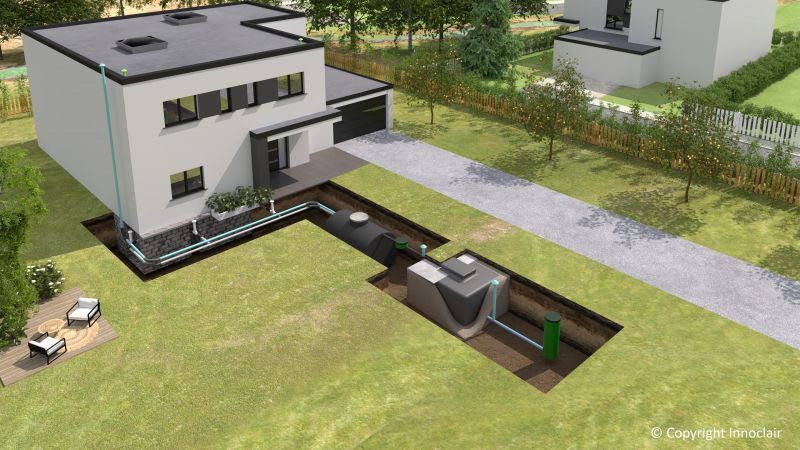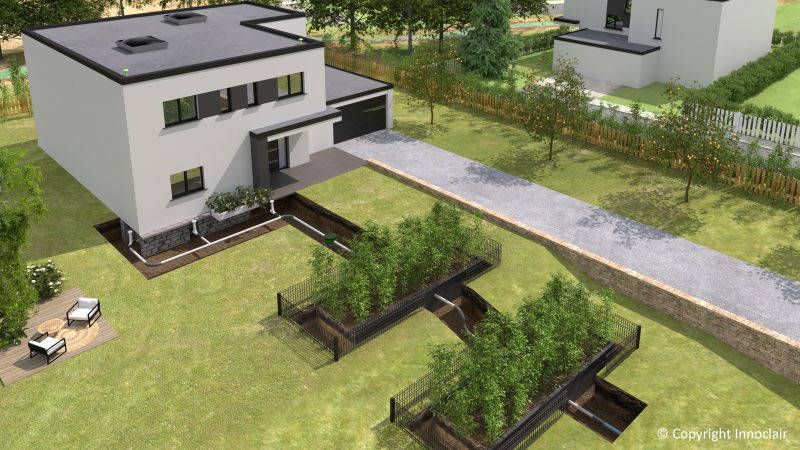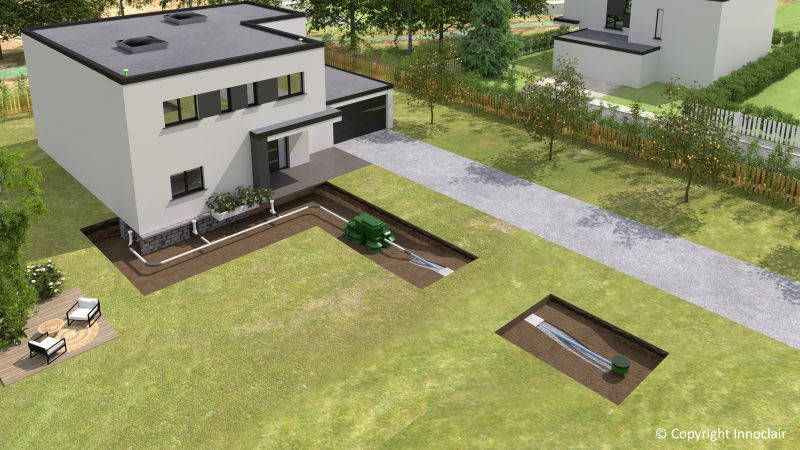What is an approved non-collective sanitation (NCS) system?
Historically, only soil-based treatment systems were recognized by health regulations. In the 1960s, micro-stations started to be developed. Compact filters appeared in the early 2000s.
All devices marketed in Europe must have passed the "CE" certification tests. To secure the investment of the users, the French state imposed an additional protocol called "Agrément ministériel". This approval adds rigor to the selection process of the various devices.
APPROVED SYSTEMS: THE BASICS
Approval for domestic use
Approved treatment systems are made up of all the sanitation solutions approved by the ministries in charge of health and ecology. The approvals obtained concern the treatment of exclusively domestic wastewater.
Limitations for secondary residences
Some approved treatment systems operate intermittently, which is why they cannot be installed in second homes.
Official list
You can consult the list of approved sanitation systems in the Official Journal on the website of the Portal of Non-Collective Sanitation by clicking here.
Smaller systems
Approved treatment systems are compact solutions, more compact than traditional systems.
THE 4 APPROVED TREATMENT SYSTEMS
There are 4 types of approved systems:
- Compact filters
- Planted reed filters
- Micro-treatment plants with fixed cultures
- Micro-treatment plants with free cultures or activated sludge
All these systems are approved by the ministries and have received a marketing authorization.
Would you like to know more about the operating mode, their advantages and disadvantages? Consult the dedicated sections.
1. COMPACT FILTERS
Two levels of treatment:
- Primary treatment is provided by an all-water tank which collects all the grey water from the house.
- The secondary treatment is carried out in a filter bed. This filter bed can be made of different materials on which the purifying bacteria are fixed:
- zeolithe,
- coconut shavings,
- rock wool,
- sand…
Wastewater evacuation
Finally, the treated water is infiltrated into the ground or discharged into the ditch, depending on the case.
Ventilation and evacuation of gases and odors
These devices include ventilation stacks visible on the ground, 2 upstream positioned at depth and 2 downstream located on the surface. These ventilation stacks allow to aerate the filter and to release the bad odors produced towards the secondary ventilation installed on the roof of the house.
ADVANTAGES
-
Approved for second homes: compact filters are among the systems authorized for second homes, unlike other systems.
-
No electrical consumption: unless the installation requires the installation of a lifting system.
DISADVANTAGES
-
Expensive filter change every 8 to 15 years (2000 to 3500 € in 2022).
-
Requires effective secondary ventilation (some give off more bad odors than others).
-
Very often require a pump at the outlet: this generates an additional cost.
-
Maintenance: great difficulty in finding a company to maintain these devices.

2. REED FILTERS
Reed filters are systems approved by the Ministry of Ecology and the Ministry of Health.
The primary treatment is provided by an all-water tank which collects all the grey water and black water from the house.
The filter planted with reeds uses the phyto-purification technique.
Grey water (washbasin, sink, washing machine, ...) and black water (WC) are sent to a basin filled with a mineral substrate (sand, gravel, ...) where different types of plants and vegetation like reeds are planted. The plants used must be local species adapted to the region. These reeds have a highly developed root system that allows them to drain the mineral support, to bring oxygen and to be used as support for aerobic bacteria. These bacteria will degrade and mineralize the organic matter (sludge). These sludges will become assimilable by the plants.
There are 2 types of reed filters:
- Vertical flow reed filters: the wastewater flows from the surface of the bed to the inside, in a vertical way.
- Horizontal flow reed filters: wastewater flows horizontally through the bed.
MAINTENANCE
Once a year, in autumn, it is necessary to proceed to the "faucardage", i.e. to cut the vegetative part of the reeds. This operation will bring oxygen to the pond.
The reeds must be cut at a height of 20 to 30 cm so that the effluents do not get inside the stems.
ADVANTAGES
-
Good purification performance.
-
No sludge production.
-
No release of bad odors.
-
Good landscape integration.
DISADVANTAGES
-
Large footprint required.
-
Maintenance and mowing to be done every year.

3. FIXED-CULTURE MICRO-PURIFICATION PLANTS
The micro-station is an all-in-one sanitation solution approved by the Ministries of Ecology and Health. It ensures the pre-treatment of wastewater, then its treatment.
Primary treatment is provided by a primary decanter (or septic tank).
The secondary treatment is carried out by the bacteria present in the biological reactor, to which oxygen is supplied. In the case of fixed-culture micro-purification plants, these bacteria are fixed on a support (mineral, plastic, etc.). The sludge is then separated from the treated wastewater by a clarifier and returned to the primary clarifier where it is stored.
The treated wastewater is discharged:
- Either by infiltration into the soil,
- or by irrigation of the plants,
- or by discharge into a ditch or a watercourse (provided that there is no other solution and that the SPANC issues a favorable opinion).
The remaining sludge is stored in one of the compartments of the micro plant and must be emptied when it corresponds to 30% of the volume of the plant.
The tanks of the microstations are made of different materials according to the choices made by the manufacturers and the models. You will find tanks made of concrete, polyethylene or polyurethane.
ADVANTAGES
-
Old and mastered technique.
-
Many suppliers.
-
Compact device.
-
Can be installed in protected areas (drinking water catchment, shellfish farming, swimming, ...).
DISADVANTAGES
-
Very high electrical consumption (compressors work 100% of the time).
-
Need a secondary ventilation on the roof of the house to avoid the appearance of bad smells. The installation of a secondary ventilation is costly and unsightly.
-
The microstations cannot be installed in secondary residences.

4. THE FREE CULTURE MICRO TREATMENT PLANT
The free culture micro plant is a compact and complete device which allows to treat your wastewater in an efficient way.
There are 2 main families of free cultures:
- The "free culture" works on the same principle as the treatment plants of large cities. This allows it not to emit bad smells or heavy greenhouse gases.
- The "SBR" technique: The SBR micro-stations "Sequencing Batch Reactor" is a version of the free culture micro-stations where the biological reaction and the clarification phase take place in the same compartment. This technique allows a lower production of bad odors than fixed culture systems or systems with an all-water tank, without however being as efficient as free-culture systems.
The mini wastewater treatment plant works on the same principle as the wastewater treatment plants of large cities. The tanks of the microstations are made of different materials: concrete, polyethylene or polyurethane tanks.
ADVANTAGES
-
Technology from the collective stations of big cities: it is a guarantee of quality and the good functioning of the device.
-
No secondary ventilation (for the models of the INNOCLAIR range).
-
Low power consumption.
-
Low ammonia discharge which allows a discharge in a ditch, a stream or a pond.
DISADVANTAGES
-
The micro-stations with free cultures cannot be installed in secondary residences.

THE INSTALLATION OF A MICRO PLANT: SIMPLE, FAST, FUNCTIONAL!
The installation of a micro-station with free cultures takes place in several stages:
- Earthwork (preparation of the ground, realization of the location of the mini-station supply, evacuation of the rubble, realization of a trench for the evacuation pipes if necessary, ...).
- Installation of the micro-station (installation, backfilling of the ground, ...).
- Connection.
- Electrical connection (to your home's electrical panel).
- Commissioning.
Installing a micro-station takes between 1 and 2 days depending on the specificities of your installation, its life span is quite long, from 30 to 50 years.


We are able to ensure the after-sales service and maintenance of the sanitation systems of:
-
Individuals.
-
Hotels, campsites, leisure parks, holiday centres.
-
Breweries & Restaurants.
-
Castles & charming houses.
-
Food production companies.
-
Wine growing companies.




